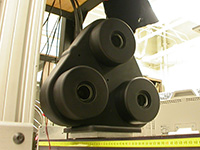Key project members: |
Development of DDPIVDefocusing Digital Particle Image Velocimetry (DDPIV) is a volumetric flow mapping technique that can measure the 3 components of velocity in a volume of fluid, thus allowing for the calculation of full derivative quantities such as vorticity. Effectively it is a multiple-aperture 3D imaging system designed to track points. Depth from DefocusThe technique was born from the realization that the intersection of the marginal rays from a point in space and the image plane move laterally as the point moves in relation to the imaging optics' focal surface—this is geometrically why out-of-focus points appear as large blurred circles. Thus if an aperture mask is made that allows three portions of the outermost rays to pass, a defocused point will be imaged as three distinct [blurred] points, the distance between which (corresponding directly to the geometric blur radius in a single-aperture system) is a direct measurement of the distance between the point and the focal surface. Moreover, the orientation of the imaged triangle indicates on which side of the focal surface the point is, something which typically cannot be ascertained from blur alone. Note the concept is in fact the "opposite" of a Hartmann mask in that instead of being used to focus a system, we used it to measure the amount of defocus. The idea is also the foundation of phase detection autofocus systems. Multiple-Lens DefocusThe concept of a single lens with multiple apertures is equivalent in the pinhole-optics sense to a multiple lens, multiple sensor arrangement. In this embodiment, it is very similar to a technique commonly referred to as 3D Particle Tracking Velocimetry (PTV), with the distinction that in DDPIV the calibration does not attempt to model the cameras and imaging optics, it instead forces the images to appear as if they were recorded through a single lens with multiple apertures. This novel calibration scheme allows for the implementation of extremely fast reconstruction algorithms because the so-called "epipolar lines" have constant slope. Principal ContributionsOriginal systems were plagued by unnecessary alignment mechanisms, unwieldy design, and thermal issues. My final design increased resolution and precision substantially and stabilized the thermal characteristics of the system. The software—in particular on the calibration side—was also made faster and more reliable. DDPIV systems are now marketed by TSI, Inc. under the name V3V. |

